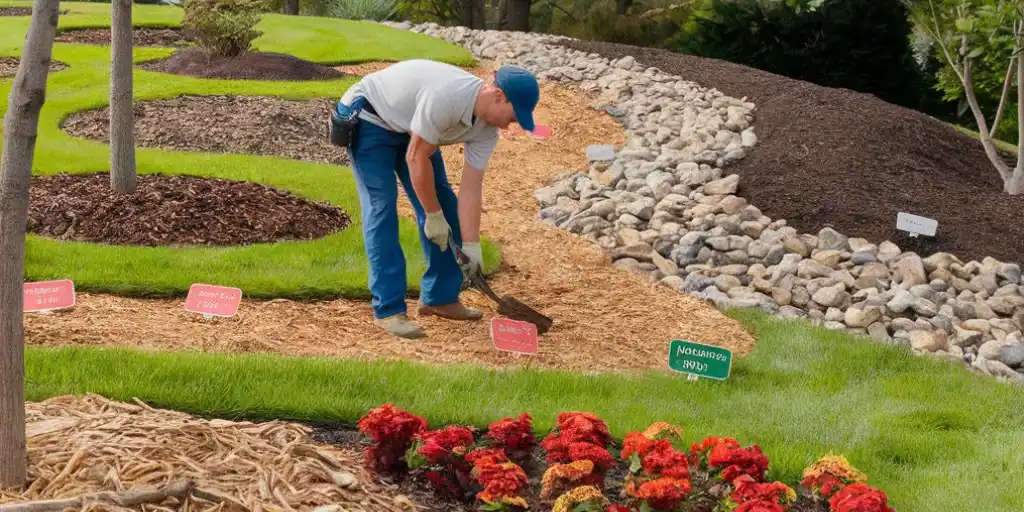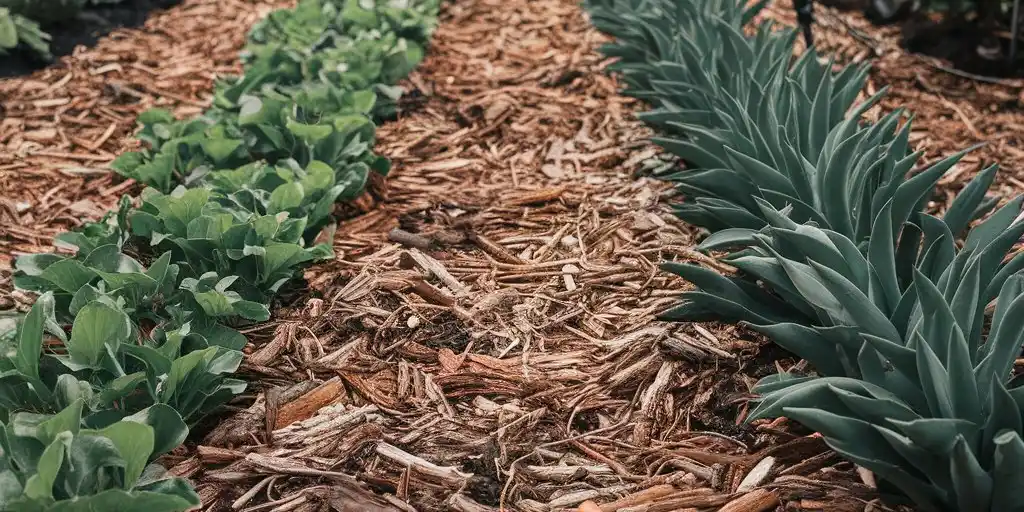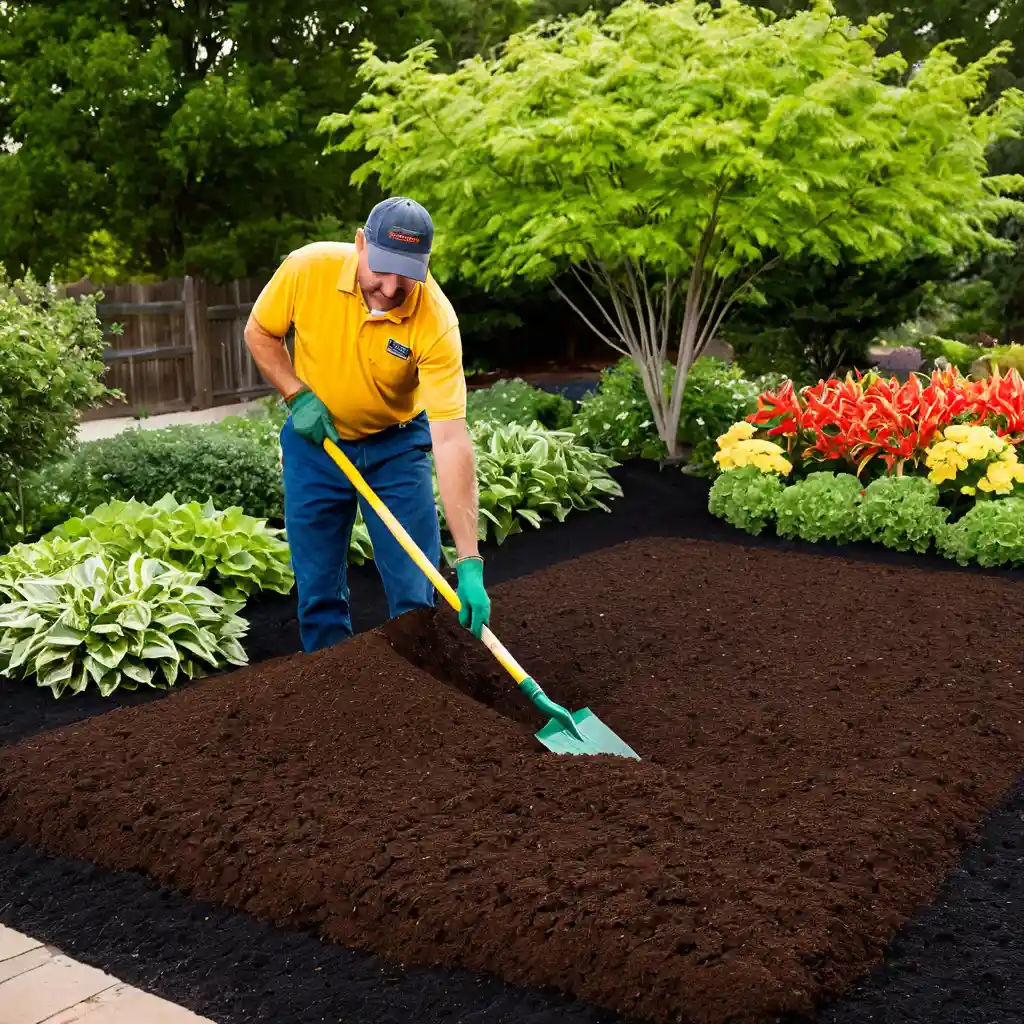Mulch is an essential tool for any homeowner or gardener seeking to improve the appearance and health of their outdoor spaces. Firstly, it enhances the look of your garden. Additionally, it plays a vital role in regulating soil health, controlling weeds, and retaining moisture. Furthermore, it helps protect plant roots from temperature fluctuations. In this comprehensive guide, we’ll explore various types, their benefits, and finally, the best application practices to keep your landscape thriving.
Types

Organic Compost “Mulch”
Organic compost, made from natural materials, breaks down over time, adding nutrients to the soil.. Popular choices include wood chips, cedar bark, and pine bark nuggets. As these materials break down, they improve soil structure, increase water retention, and foster beneficial microbial activity. Organic mulches make gardens look better and stay healthy for a long time.
Common Types
- Wood Chips: A versatile option that works well around trees and garden beds.
- Bark Mulch: Cedar and pine bark are long-lasting and have natural insect-repelling properties.
- Compost: Provides direct nutrient benefits, making it perfect for vegetable gardens.
Stone Mulch
Stone mulch, made from rocks, gravel, or pebbles, is a type of compost that does not break down like organic compost .It’s a popular choice for stabilizing areas prone to erosion, such as slopes.Stonecompost is a good choice for places where you need to prevent weeds, but improving the soil isn’t your main concern. One of its advantages is color permanence—stones don’t fade over time like organic materials.
Key Features
- Great for erosion control.
- Permanent color and texture.
- Best used in areas where water drainage is a concern, such as near downspouts.
Colored Mulch
For those who want to add a decorative flair to their garden, colored compost is a great option. Made from wood that’s dyed with vegetable-based pigments, this type of compost is available in a variety of colors, including red, brown, and black. Color retention is a major selling point of colored mulch, as it can last two to three years before fading.
Benefits
- Adds aesthetic value with long-lasting colors.
- Helps with weed control and water retention.
- Available in finer textures for more precise application.
Cocoa Bean Mulch
For a unique and luxurious option, consider cocoa bean mulch. It has a rich, chocolatey scent and provides nutrients as it decomposes. However, it’s crucial to note that cocoa bean compost is not safe for dogs, as it contains theobromine, a chemical harmful to canines.
Highlights:
- Deep brown color and pleasant aroma.
- Decomposes to improve soil health.
- Requires careful application to avoid mold buildup.
Benefits of Mulch
Water Loss Prevention
it plays a crucial role in reducing water loss by slowing down evaporation from the soil. This is particularly important during hot, dry seasons. Organic mulches like wood chips and bark help improve water absorption when it rains or when watering systems are used.

Weed Control
One of the primary reasons gardeners use mulch is to reduce the number of weeds that grow in garden beds. By adding a 3 to 4-inch thick layer of it, you can prevent sunlight from reaching weed seeds, effectively stopping them from germinating.
Soil Enrichment and Decomposition
Organic compost gradually breaks down, enriching the soil as it decomposes. Mulches made from bark or compost are excellent for improving the soil’s nutrient content and structure. This process fosters healthier plant growth by enhancing root development and preventing root rot.
Temperature Regulation for Plant Roots
Compost helps moderate temperature fluctuations in the soil. During the summer, it keeps the soil cool, protecting plant roots from overheating. In the winter, it acts as insulation, preventing the soil from freezing and safeguarding your plants from temperature extremes.
Erosion Control
stone mulch, helps with erosion control on slopes and other areas prone to soil washout. By stabilizing the soil, it prevents rain or irrigation water from eroding the topsoil, which is essential for maintaining healthy garden beds.
Application Techniques
Applying it on Slopes
When applying it on slopes, it’s important to choose materials that will stay in place. For organic mulch, shredded bark works best as it mats together and doesn’t wash away easily. Stone compost is also a reliable choice for preventing erosion in sloped areas.
Proper Depth and Thickness: Using a Mulch Calculator
For most garden beds, a 3 to 4-inch layer of compost is ideal. Too little won’t suppress weeds or retain moisture effectively, and too much can suffocate plant roots. Use a compost calculator to determine the amount of compost you’ll need. Simply multiply the length and width of your garden bed by the desired depth (in cubic feet), then divide by 3 to get the volume in cubic feet.
Example :
- For a garden bed that’s 10 feet long and 5 feet wide, applying a 4-inch layer requires: (10×5)/3=16.67cubic feet of mulch “CFM”(10 x 5) / 3 = 16.67 CFM(10×5)/3=16.67 CFM.
Use of Landscape Fabric
Landscape fabric is often placed under mulch to prevent weeds from growing through. It works well under stone compost, helping to keep the stones in place and slowing down weed growth. However, it’s not recommended for use under organic compost, as it prevents the mulch from decomposing into the soil and enriching it.
Maintenance
Color Retention and Mulch Longevity
compost naturally fades over time due to exposure to sunlight and the elements.to maintain the vibrant color of your colored compost you may need to refresh it every two to three years.Inorganic mulches, like stones, have the advantage of not fading over time but may need periodic cleaning to maintain their appearance.
Preventing Root Rot
One of the common mistakes in mulching is applying it too close to the base of trees and plants, which can cause root rot. Ensure that mulch is pulled back at least 6 inches from the base of plants to prevent this problem.
Cleaning Mulch Areas: Leaf Vacuum
Maintaining Compost-covered areas requires regular cleaning to remove leaves and other debris, especially when using stone mulch.A leaf vacuum can be used to clean the compost surface without disturbing the layer too much,keeping your garden looking neat and well-maintained.
FAQs: Mulch Guide
Q1: What is the best type of mulch for my garden?
A1: The best type of mulch depends on your garden’s specific needs.
For instance, if you’re looking to enrich the soil, organic mulches like wood chips or compost are ideal.
However, for erosion control or aesthetic appeal, stone or colored mulch might be a better option.
In addition, consider whether you need weed control, soil enrichment, or both when making your choice.
Q2: How often should I replace my mulch?
A2: Organic mulches should be replenished every one to two years as they break down over time.
Conversely, colored mulch can last two to three years before needing a refresh.
On the other hand, stone mulch is a long-term option that requires little replacement, though it may need occasional cleaning to maintain its appearance.
Thus, the type of mulch will determine how frequently it needs to be replaced.
Q3: How thick should I apply mulch?
A3: Generally, a 3 to 4-inch layer is ideal for most garden beds.
Nevertheless, applying mulch too thinly won’t effectively suppress weeds, and too much could suffocate plant roots.
Therefore, it’s essential to strike the right balance, and using a compost calculator can help you determine the exact amount needed based on your garden’s dimensions.
Q4: Can I use landscape fabric under mulch?
A4: Yes, you can use landscape fabric, but it depends on the type of mulch.
For Stone compost:
It’s highly effective under stone mulch, preventing weeds while allowing water drainage.
For Organic Mulch:
However, it’s not recommended for use with organic mulch, as it stops the mulch from decomposing into the soil.
Ultimately, the choice to use fabric depends on whether soil enrichment or weed prevention is your priority.
Q5: What are the main benefits of using mulch?
A5: Mulch provides several advantages, including moisture retention, weed control, and soil temperature regulation.
For Organic compost:
Moreover, organic compost enriches the soil as it decomposes.
For Stone Mulch:
Additionally, stone mulch offers long-lasting erosion control.
For Colored compost:
Colored compost enhances your garden’s aesthetic appeal with vibrant, long-lasting hues.
Altogether, It is an essential tool for maintaining a healthy, low-maintenance landscape.
Conclusion
Choosing the right Compost for your garden not only enhances its beauty but also improves the overall health of your plants. Whether you opt for organic compost to enrich the soil, stone compost for durability, or colored mulch to add visual appeal, it’s important to apply and maintain compost correctly to reap its full benefits. With proper application techniques and regular upkeep, you’ll enjoy a healthier, more vibrant garden that requires less watering, weeding, and maintenance.
Want to learn more? Check out our related article here "Rubber Mulch vs. Wood Mulch" for deeper insights!

